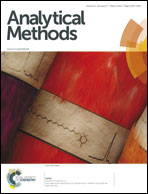Preconcentration and determination of pesticides with graphene-modified polymer monolith combined with high performance liquid chromatography
Abstract
In this study, a graphene-modified poly(butyl methacrylate–ethylene dimethacrylate) monolithic column was successfully utilized for purification and enrichment of four pesticides (fludioxonil, cyprodinil, flusilazole, and triflumizole) in fruit and vegetable samples. Several experimental parameters affecting the extraction efficiency were investigated, such as sample pH, sample flow rate, sample volume, salt concentration, eluent type, and eluent flow rate. Combined with HPLC analysis under the optimized conditions, good linearities were obtained for all targets with R2 values greater than 0.9965. The limits of detection (S/N = 3) for four pesticides were found to be in the range of 0.93–3.0 μg kg−1. The intra-day and inter-day relative standard deviations, ranging from 3.4% to 6.2%, were within an acceptable scope. Compared with direct HPLC analysis and preconcentration with unmodified poly(butyl methacrylate–ethylene dimethacrylate) monolith, the incorporation of graphene into the monolith increased the enrichment capacity for the analytes. The developed method was successfully applied to the determination of pesticides in fruit and vegetable samples (apple, grape, orange, tomato, cucumber, rape). The recoveries of four pesticides at different spiked levels in the samples were in the range of 70.2–95.0% with the relative standard deviations less than 6.4%.


 Please wait while we load your content...
Please wait while we load your content...